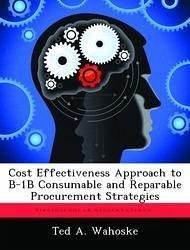The use of a cost effectiveness methodology to evaluate inventory procurement strategies can provide added insight into the best possible use of limited financial resources. This research utilized a cost effectiveness approach to evaluate the procurement of B-1B bomber spare parts used for base-level maintenance operations. Average number of backorders and average MICAP hours data for 32 Federal Supply Class (FSC) categories were drawn from an Arena simulation model based on historical supply and maintenance data from Ellsworth Air Force Base, along with corresponding cost data from the Air Force Total Ownership Cost database. With this data, the cost per average MICAP hour for each FSC were analyzed to gain insight into which FSCs are most likely to positively influence MICAP hour reductions in a cost effective manner. This exploration highlighted the benefits of targeting FSCs with a low procurement cost to cost per MICAP hour ratio to capitalize on the efficient use of appropriated funding and the subsequent effect on MICAP hour reductions.
Hinweis: Dieser Artikel kann nur an eine deutsche Lieferadresse ausgeliefert werden.
Hinweis: Dieser Artikel kann nur an eine deutsche Lieferadresse ausgeliefert werden.








